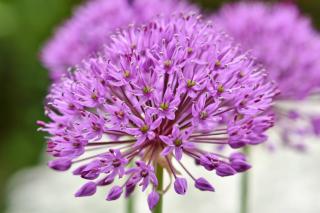

Giant onion is a superb flower, with amazing tall flower stalks.
Short list of Giant onion facts
Name – Allium giganteum
Family – Liliaceae (lily family)
Type – perennial
Height – 8 to 40 inches (20 to 100 cm)
Exposure – full sun
Soil: ordinary – Flowering: end spring → mid-summer
Easy to grow, it is perfect in flower beds and also in pots or garden boxes to decorate either a terrace or a balcony.
Giant onion is planted in fall more or less 4 to 5 inches (10 to 12 cm) deep in light soil.
A good way to know how deep to plant it is to multiply the height of the bulb by 3. If it is 2 inches (5 cm) tall, plant at a depth of 6 inches (15 cm).
Caring for giant onion is extremely easy, since the needs of this perennial bulb plant are not complicated.
In both pots and in the ground, they will bear nice flowers without asking you to care for them.
 Cut wilted flower scapes as they die off, cutting the stem off as short as you can.
Cut wilted flower scapes as they die off, cutting the stem off as short as you can.Note that giant onion leaves tend to turn yellow before or after the blooming of the large umbels, and so it helps to plant ground-covering perennials around the giant onion plants, to cover the wilted leaves and only let the flower stem stick out.
As for pot-growing giant onion, remember to water regularly because water needs are higher due to the fact that potted plants tend to dry off faster.
These are stupendous plants. A few varieties will illustrate how amazing these flowers are:
Giant onion is a perennial that grows quite easily and which will produce very beautiful purple blue flowers that can be up to 8 to 12 inches (20 to 30 cm) across.
Native to Europe and Asia, this ornamental onion belongs to the same genus as the following species: edible garlic, onion, shallot, chives and is in the same family as leek.
Giant onion varieties all boast superb flowers bunched up in balls and the size and color of this ball depends on the variety.
In flower beds or along edges, and also along a wall or simply plunked in the middle of the yard, the ornamental impact of this plant is guaranteed!
It is also used in flower bouquets, because the foliage and the flowers both can be used to make appealing bouquets.
For the taller species you can stake the stem to keep it from folding under the wind. Nice for this is to use bamboo, it is perfectly suited and actually enhances the visual impact of the plant.
I have a patch of these that has been multiplying for the past few years. How/when can I transplant? I’d like some in my veggie garden as I’ve read they deter rabbits.
Hello Adam! That’s a great idea, Allium or Giant onion are indeed rabbit repellents. The best time to transfer them is at the end of summer or fall. Wait for the leaves to die out and turn yellow. Then, dig the bulbs out and plant them in your veggie patch at the same depth they were before (approximately).
A good idea is to set a marker in the ground as you plant them, like a stick or tube, so that you’ll remember where they are once the soil has settled down a bit. That way you won’t inadvertently dig them out when preparing the plot in spring or at the end of winter…
I have some sort of Allium that is a mystery to me. I read that the tallest Allium is Allium giganteum (Ornamental Onion) at 5-6 ft. but mine are 7-8 feet at maturity, what could they be?
Wow! That does seem extremely tall! I also concur that the tallest is normally Allium giganteum. To know if it’s a different species, at this point, we’d need a specialized botanist.
It’s more likely to actually also be an Allium giganteum with particularly vigorous traits – grown in a particularly suitable environment! Perhaps you fertilized the soil in a special way, or the sun/shade timing is perfect. It must be very impressive. You’re quite the lucky one!